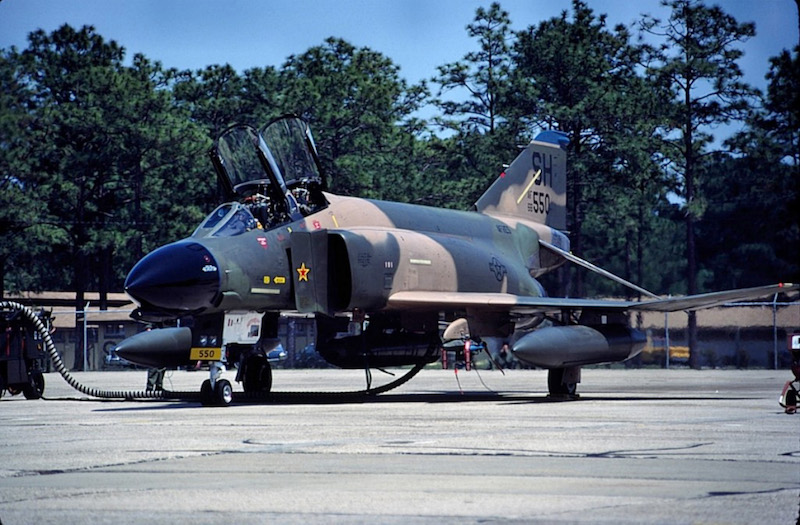
The McDonnell Douglas F-4 Phantom II is the most significant fighter aircraft of the 20th Century. First flown on May 27, 1958, the Phantom II entered service with the Navy, Marine Corps and Air Force. The Air Force’s initial version was the F-4C which first flew in 1963. For the most part, this article will focus on the versions operated by the Air Force, Air National Guard and Air Force Reserves.
The F-4 has two cockpits in tandem for a pilot in the front seat and radar/navigator or weapon system officer in the back. The highly-swept, low-wing design has dihedral outer wing panels (up-turned) offset by horizontal stabilizers with an anhedral (down-turned) angle. The jet sits on tricycle landing gear and has large air intakes for the jet engines with air controlled by variable-ramps at the intakes leading edge. For a fighter, the F-4 is a massive, heavy-weight hitter with a maximum take-off weight of 61,795 pounds.
The mach-two plus capable aircraft was originally designed as a Navy carrier-borne fighter/bomber and all version of the Phantom II have a robust tail hook between the engine nozzles, under the tail. The folding outer wing panels suited it well to carrier operations with the Navy and Marine Corps and in revetments with all services when conducting land-based operations during the Vietnam War.
Tinker played an important role in the sustainability of Air Force F-4s from the start through J79 engine maintenance and overhaul between Aug. 1966 and Sept. 1993. There was also a short period of time, July 1970 to June 1972, when some depot level maintenance, overhaul and upgrades/modification were conducted as 101 F-4s passed through the Oklahoma City Air Logistics Center. The work at OC-ALC helped boost Air Force F-4 overhaul production numbers as F-4s were heavily involved in combat operations in Southeast Asia during the Vietnam War. Work soon shifted back to the Ogden Air Logistics Center, Hill AFB, Utah or to in-theatre centers such as Clark Air Base, Philippines.

At the same time F-4C aircraft were rolling off the McDonnell Douglas production line in St. Louis, beginning in 1963 a version of the same basic airframe optimized for the tactical reconnaissance role were also being produced as the RF-4C. The RF-4C had a slightly longer, sleeker nose fitted with a smaller radar in the front cone and a camera bay with four film-based cameras operated by the navigator to give horizon-to-horizon, forward view and right/left oblique coverage. RF-4Cs were critical during the Vietnam War and later during Desert Shield/Storm in locating targets while operating ‘unarmed and unafraid.’ There were 583 F-4Cs and 505 RF-4Cs purchased by the USAF.
F-4Es had improved performance engines and leading edge slats were introduced as standard configuration on later E-models to increase the maneuverability and stability of the aircraft at slower speeds during ground-attack profiles and air combat maneuvering. Some F-4Es were fitted with, at the time, sophisticated electro/optical systems in the leading edge of the right wing for improved precision strike capability.

The U.S. military’s last aces, pilots or crewmembers credited with five or more kills, were produced flying the F-4 Phantom II. Over 100 enemy MiGs were shot down during the Vietnam War with ace status attained by Air Force and Navy pilots or crewmembers. Additionally, the F-4 is the only aircraft operated both by the Navy Demonstration Team, Blue Angels, and their Air Force counterparts, The Thunderbirds.
April 5, 1981 Photographer – Peter Wilson via David F. Brown

The final USAF F-4s were retired from the operational inventory in 1997. This retirement did not end the F-4s story with the Air Force as the aircraft had much more to offer as a target for air-defense systems and in training for fighter-pilots during live-fire missile training opportunities. Many USAF F-4s were converted in to full-size aerial targets and the QF-4s served until again being retired after a final flight on Dec. 21, 2016, at Holloman AFB, New Mexico.

































